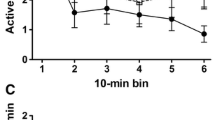Abstract
Eight volunteers with histories of drug abuse participated in two experiments examining the modulation of drug choice by behavioral requirements following drug ingestion. Each morning subjects ingested colorcoded capsules containing triazolam (0.25 mg),d-amphetamine (15 mg), or placebo and then engaged in a relaxation or a computer vigilance activity. Experiment 1 involved two phases (i.e. a triazolam and ad-amphetamine phase), presented in counterbalanced order. Within each phase, subjects were first exposed to each of two compounds (placebo and either triazolam ord-amphetamine) once with each activity. Then every other day for 20 days subjects chose which compound they ingested with the vigilance and relaxation activities, with the restriction that they could not choose the same compound with both activities. Seven of eight subjects reliably chosed-amphetamine with the vigilance activity; all subjects always chose triazolam with the relaxation activity. In experiment 2 (5 days' duration), after re-exposure to the color-coded compounds used in experiment 1, subjects chose which compound (placebo,d-amphetamine or triazolam) they ingested with the vigilance activity, and on another occasion (in counterbalanced order), which they ingested with relaxation activity. Seven of eight subjects chosed-amphetamine with the vigilance activity; all subjects chose triazolam with the relaxation activity. The relaxation and vigilance activities modulated triazolam andd-amphetamine reinforcement, thereby demonstrating a new class of environmental variable that can influence drug self-administration.
Similar content being viewed by others
References
Azrin NH (1961) Time-out from positive reinforcement. Science 133:382–383
Cotton P (1990) Medium isn't accurate ‘ice age’ message. JAMA 263:2717
Falk JL, Samson HH, Winger G (1972) Maintenance of high concentration of blood ethanol and physical dependence in the rat. Science 177:811–813
Freud S (1975) Über coca. In: Byck R (ed) Cocaine papers by Sigmund Freud. Meridian, New York, pp 48–73
Goldberg SR, Woods JH, Schuster CR (1969) Morphine: conditioned increases in self-administration in rhesus monkeys. Science 166:1306–1307
Griffiths RR, Bigelow GE, Henningfield JE (1980a) Similarities in animal and human drug-taking behavior. In: Mello NK (ed) Advances in substance abuse. JAI Press, Greenwich, pp 1–90
Griffiths RR, Bigelow GE, Liebson I, Kaliszak JE (1980b) Drug preference in humans: double-blind choice comparison of pentobarbital, diazepam and placebo. J Pharmacol Exp Ther 215:649–661
Holand L (1990) All about “ice”: New drug nice kids can get hooked on. Good Housekeeping 210:215
Johanson CE, Schuster CR (1981) Animal models of drug self-administration. In: Mello NK (ed) Advances in substance abuse: behavioral and biological research. JAI Press, Greenwich, pp 219–297
Lerner MA (1989) The fire of ‘ice’. Newsweek 114:37
McKearney JW (1968) Maintenance of responding under a fixed-interval schedule of electric shock presentation. Science 160:1249–1251
Morse WH, Mead RN, Kelleher RT (1967) Modulation of elicited behavior by a fixed-interval schedule of electric shock presentation. Science 157:215–217
O'Koon M (1989) Dangerous new drugs on the teen market. Good Housekeeping 208:235
Pickens R, Meisch RA, Thompson T (1978) Drug self-administration: an analysis of the reinforcing effects of drugs. In: Iversen LL, Iversen SD, Snyder SH (eds) Handbook of psychopharmacology. Plenum, New York pp 1–37
Spealman RD (1979) Behavior maintained by termination of a schedule of self-administered cocaine. Science 204:1231–1233
Steiner SS, Beer B, Shaffer MM (1968) Escape from self-produced rates of brain stimulation. Science 163:90–91
Stretch R, Orloff ER, Dalrymple SD (1968) Maintenance of responding by fixed-interval schedule of electric shock presentation in squirrel monkeys. Science 162:583–586
Wise RA, Yokel RA, de Wit H (1976) Both positive reinforcement and conditioned aversion from amphetamine and from apomorphine in rats. Science 191:1273–1275
Young AM, Herling S (1986) Drugs as reinforcers: studies in laboratory animals. In: Goldberg SR, Stolerman IT (eds) Behavior analysis of drug dependence. Academic Press, Orlando, pp 9–67
Author information
Authors and Affiliations
Additional information
Portions of these data were presented at the annual meeting of the Association for Behavior Analysis, Atlanta, June, 1991
Rights and permissions
About this article
Cite this article
Silverman, K., Kirby, K.C. & Griffiths, R.R. Modulation of drug reinforcement by behavioral requirements following drug ingestion. Psychopharmacology 114, 243–247 (1994). https://doi.org/10.1007/BF02244844
Received:
Revised:
Issue Date:
DOI: https://doi.org/10.1007/BF02244844




